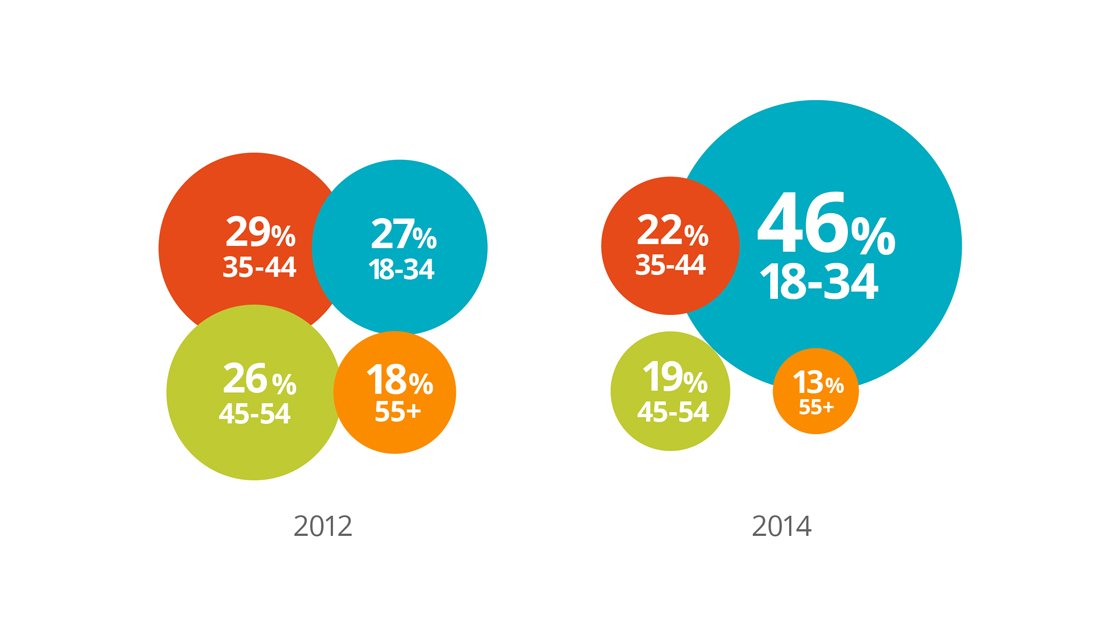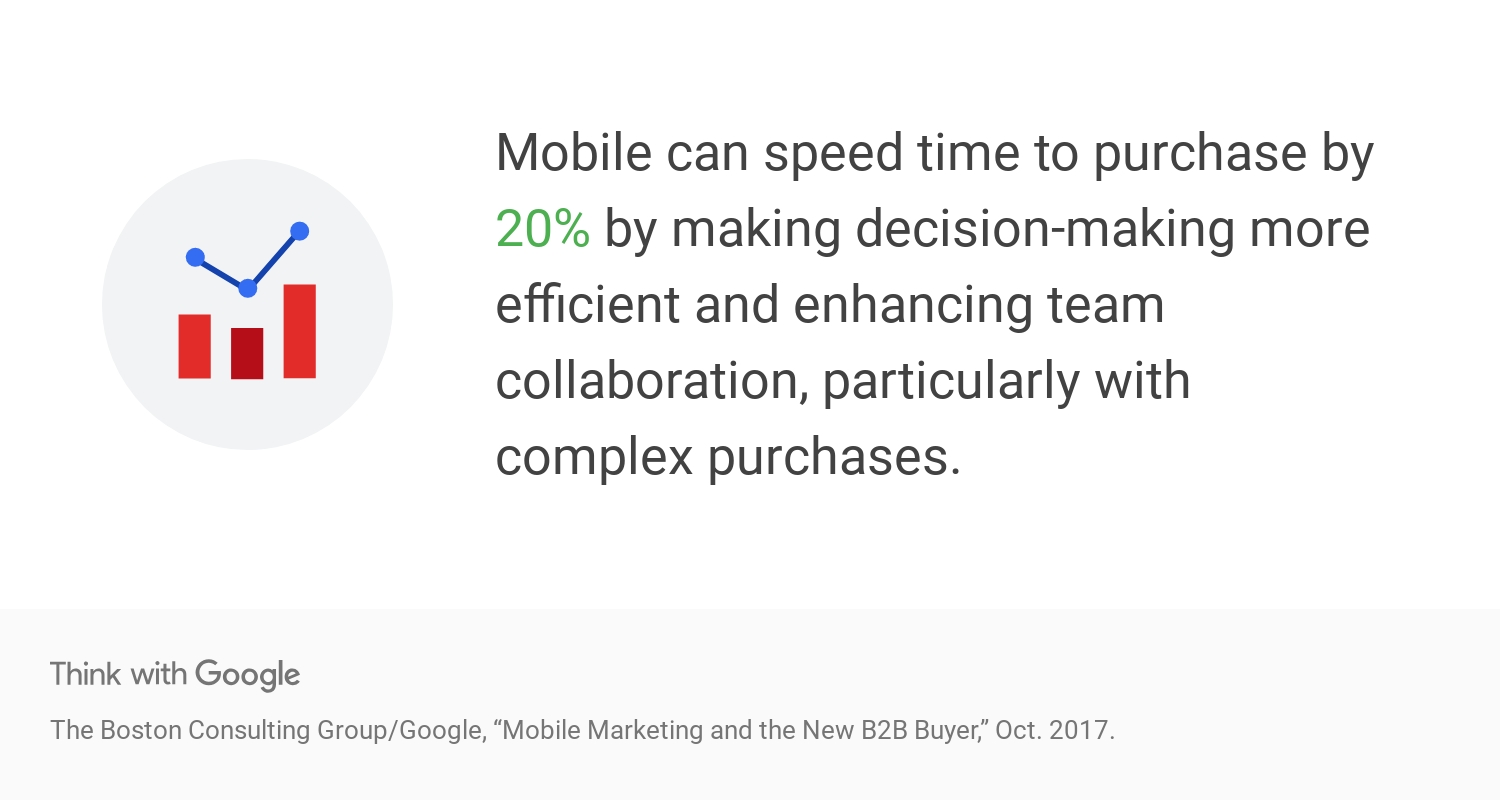In the dynamic world of B2B marketing, trends change quickly! With sales opportunities waiting to unfold, crafting an effective B2B marketing strategy is an art and science.
At Blue Noda, we love the challenge! From navigating lengthy sales cycles to engaging with well-informed buyers, we help our clients tackle this unique challenge for companies focusing on B2B sales and services.
In pursuing B2B marketing excellence, we have decided to share some vital statistics shaping the broad industry.
General B2B Marketing Statistics

- 64% of all B2B buyers are millennials and Gen Z. (Digital Commerce 360)
- 75% of B2B customers prefer a rep-free sales experience. (Gartner)
- 3% of companies are taking a “customer-obsessed” approach to marketing. (Forbes)
- 95% of American Adults say they use the Internet. (Pew Research)
- 37% of digital buyers engaged with a supplier’s website before purchasing. (Gartner)
- Eighty-four days is the average length of the B2B sales cycle, attributed to a well-developed funnel. (Zipdo)
- 49% of all B2B spending is online. (VML)
- 67% of B2B buyers begin their purchase journey online. (Kurve)
Insights And Takeaways
We are seeing a fascinating shift, with 64% of B2B buyers now being millennials and Gen Z, according to Digital Commerce 360. This demographic shift fundamentally changes the landscape as these younger buyers bring their digital-first approach into the B2B space. In alignment with their preferences, a whopping 75% of B2B customers are now favoring a sales experience that does not require a representative, per Gartner’s findings. These trends signal a clear preference for streamlined, efficient purchasing processes.
Interestingly, despite the significant impact of customer-centric strategies on business success, only 3% of companies have fully embraced a customer-obsessed marketing approach, as reported by Forbes. This statistic highlights a massive opportunity for businesses willing to put their customers at the heart of their strategies.
The digital world is an integral part of our lives, and the Pew Research Center notes that 95% of American adults use the internet. This widespread adoption plays a crucial role in shaping buying habits, as indicated by Gartner’s finding that 37% of digital buyers engage with a supplier’s website before making a purchase.
Furthermore, according to Zipdo, the B2B sales cycle, averaging 84 days, reflects the importance of a well-developed funnel for navigating the complexities of B2B transactions. This extended cycle emphasizes the need for relationships and building trust over time.
Meanwhile, VML’s statistic that 49% of all B2B spending happens online showcases the increasing shift towards digital platforms for business transactions. This trend will likely continue growing, highlighting why companies should invest in a robust online presence.
Additionally, as Kurve points out, the journey for B2B buyers is increasingly starting in the digital realm, with 67% beginning their purchase process online. This statistic underscores the urgency for businesses to optimize their digital marketing strategies to ensure that online touchpoints are engaging, informative, and accessible to this tech-savvy audience.
These statistics convey a clear message: the future of B2B sales is digital, personalized, and rep-free. Companies that quickly adapt to these evolving buyer preferences by investing in digital platforms and adopting a customer-centric approach will stay ahead of the curve and create meaningful, lasting connections with their clients.
Statistics Around the Complex Evolution of B2B Marketing
- 73% of B2B buyers expect omnichannel engagement with brands. (LinkedIn)
- B2B buyers have increased their online spending by 43% (Kurve)
- 77% of B2B buyers said their last deal was “overly complex.” (TechJury)
- 38% of B2B buyers do a more detailed ROI analysis, while 31% invest more time in research before making buying decisions. 23% say peer recommendations or review sites helped influence their decision. (Marketing Charts)
- An average of five (5) decision-makers are involved in the sales process. (HubSpot 2024 Sales Trend Report)
- In 2023, US-based B2B online/digital sales were expected to exceed three trillion USD. (Statista)
- 68% of B2B buyers have plans to increase their use of digital shopping channels. (VML)
Insights And Takeaways
As LinkedIn highlights, 73% of B2B buyers seek an omnichannel experience. They want to interact with brands across multiple platforms seamlessly. These prospects crave convenience and flexibility when engaging with businesses.
Kurve reveals an impressive uptick in online spending by B2B buyers, who have increased their expenditures by 43%. This surge underscores the growing confidence and preference for digital channels in the B2B realm.
However, it could be smoother sailing. TechJury says 77% of B2B buyers describe their latest purchasing experience as “overly complex.” Complications add hurdles, potentially slowing or deterring purchases.
Regarding making informed decisions, Marketing Charts says that 38% of B2B buyers dive deeper into ROI analyses, and 31% dedicate more time to research products and services before committing. Additionally, 23% rely on peer recommendations or reviews, highlighting the importance of social proof in the decision-making process.
The sales journey is rarely a solo venture. HubSpot’s 2024 Sales Trend Report reveals that an average of five decision-makers are involved in B2B sales processes, making consensus key to closing deals.
Lastly, VML’s finding that 68% of B2B buyers plan to ramp up their use of digital shopping channels signals a significant trend toward online commerce. Buyers are not just going digital; they are deepening their engagement.
What does all this mean? The message is loud and clear: B2B buyers are embracing digital avenues like never before, yet they are calling for simplicity and efficiency. As brands strive to meet these demands, creating straightforward, omnichannel experiences will be crucial. The future of B2B buying is digital, interconnected, and customer-focused, marking an exciting era of innovation and growth.
B2B Content Marketing Statistics
- 71% of B2B marketers downloaded and consumed multiple digital assets from potential vendors to help them make purchase decisions. Further, an equal number stated they shared this information with other key team members. (NYT Licensing)
- 97% of marketers integrate content marketing into their overall marketing strategy. (Kurve)
- Companies that maintain a blog produce 67% more monthly leads than those that do not blog. (Hubspot)
- The average blog post is 1,427 words long, 77% longer than ten years ago. The time it takes to produce a blog has increased slightly, taking an average of 4 hours and 10 minutes. (OrbitMedia)
- 33% of marketers leverage blog posts in their overreaching marketing strategy. (Hubspot)
- 50% of marketing teams outsourced at least one component of their content marketing activity. (Kurve)
- Content marketing costs 62% less than traditional marketing. (Demand Metric)
- 90% of B2B decision makers and buyers research 2-7 websites before purchasing. (Kurve)
- 57% of marketers said creating the “right” content for their audience was among their challenges. Other challenges included creating content consistently, differentiating the content, and optimizing the content for search. (Content Marketing Institute)
- 70% of people feel closer to a company due to content marketing. (Demand Metric)
- Less than 50% of marketers use brochures, product or technical data sheets, interactive content, research reports, audio, and live streaming as part of their content marketing strategy. (Content Marketing Institute)
- 43% of readers admit to “skimming” posts instead of thoroughly reading them. Some SaaS businesses report up to 400% growth in lead generation from their effective content marketing initiatives. (Powered By Search)
- Interest and demand for Interactive content is increasing. 62% report investing in this in 2024, versus 36% in 2023. (Seige Media)
- 53% of marketers plan to “repurpose” content as part of their marketing strategy. (VIB)
- 71% of B2B content marketers said content marketing is more critical this year than last. 40% have a documented content marketing strategy and follow it, while 33% do content marketing without any supporting documentation. (Content Marketing Institute)
- Personalized content produces a 20% increase in sales opportunities. (NYT Licensing)
Insights And Takeaways
B2B marketing is buzzing with digital innovation and strategic content creation. As highlighted by NYT Licensing, 71% of B2B marketers are diving deep into digital assets from potential vendors, not just for their insights but also to share with their teams. This collaborative approach underscores the collective effort in making informed purchasing decisions.
Content marketing is the backbone of marketing approaches, with a staggering 97% of marketers implementing it into their overall strategy, according to Kurve. HubSpot says blogs are shining stars in the content cosmos, with companies that blog generating 67% more leads monthly. And they are becoming more thoughtful and detailed, with an average of 1,427 words per post. It is a commitment, taking over four hours to craft each post, but it is an investment that marketers are willing to make for the promise of engagement and leads.
It is worth noting that it is about creating and crafting the “right” content. As the Content Marketing Institute pointed out, fifty-seven percent of marketers are tackling the challenge of aligning content with audience needs, striving for consistency, differentiation, and SEO optimization. Despite these hurdles, the impact is undeniable, with 70% of people feeling a stronger connection to companies thanks to content marketing.
Nevertheless, there is room for growth and innovation, especially in underutilized formats like interactive content, which is seeing a surge in interest. Siege Media reports a significant increase in interactive content investment, promising to make marketing experiences more engaging and effective.
Marketers are getting savvy about repurposing content. According to VIB, 53% use this approach to maximize their content’s reach and lifespan. And with 71% of B2B content marketers emphasizing the growing importance of content marketing, the commitment is clear. Personalization is vital, with tailored content boosting sales opportunities by 20%, proving that in the world of B2B marketing, it is not just what is said but how relevantly and engagingly it gets communicated.
High-Converting Content
- Sales funnels that include long-form landing pages generate as much as 220% more leads. (Persuasion Nation)
- 1.8% is the average conversion rate for B2B e-commerce. (VWO)
- Companies that incorporate link-building into their digital strategy report a 45% higher success rate than companies that do not build links. (Seige Media)
- The most critical metrics to B2B marketers measure success: 73% on website conversions, 71% on email engagement, 71% on website traffic, 69% on website engagement, and 65% on social media analytics. (WebFX)
- Interactive Content gets 28% more views than non-interactive content. (Media Fly)
- Direct website traffic boasts the best average conversion rate at 3.3%. Paid search comes in second with a conversion rate of 3.2%. The conversion rate of referrals is 2.9%, while organic search converts 2.7%. (Convertica)
- 66% of people who start filling in an online form complete the submission. However, only 45% of people who visit a form will successfully convert. (Zukio)
Insights And Takeaways
These stats are like uncovering a treasure map for boosting B2B leads, conversions, and discovery. Understanding that long-form landing pages are effective lead magnets, pulling in up to 220% more prospects, according to Persuasion Nation, is a game-changer!
Now, let us talk about conversion rates. The average for B2B e-commerce sits at a modest 1.8%, as per VWO. It might sound small, but every fraction of a percent counts represents an incremental gain. Furthermore, a nugget of wisdom from Siege Media: a digital strategy that includes link building can skyrocket success rate by 45%. It is like laying down digital breadcrumbs that lead people to the site.
WebFX sheds light on what B2B marketers hold dear: website conversions, email engagement, and traffic are the top metrics they watch like hawks. Other metrics include site engagement rates and social media reach and buzz.
Media Fly tells us interactive content is not just winning but outperforming non-interactive content by attracting 28% more views.
Traffic sources matter! Convertica reveals that direct website traffic is the conversion king, followed closely by paid search and referrals. Organic search is slightly behind, proving that an ever-growing online presence keeps things moving.
Lastly, a curious insight from Zukio: while 66% of people will complete an online form they started, only 45% of those who visit will begin filling it out. It is a reminder that every step of the customer journey is a critical opportunity to convert interest into action.
B2B Web Design Statistics

- 46% of website users prefer the color blue in website design, while only 23% enjoy yellow. Furthermore, 46% of visitors will leave a website if it is slow or they experience issues. (ColorWhistle)
- 83% of B2B e-commerce website traffic originates from desktop devices. This number is not unexpected, as desktop computers are still commonplace in most business/work environments. (Statista)
- 75% said website design determines whether people feel a business is credible. (Web FX)
- 74% of B2B buyers said they prefer human-powered customer support over chatbots, even if they have to wait for assistance. (Harvard Business Review)
- 44% of B2B buyers will leave a website if they do not see or cannot find contact information. (UK Webhost Review)
Insights And Takeaways
Blue wins the popularity contest in website design, with 46% of users showing a preference. Yellow, on the opposite side of the spectrum, only captures the hearts of 23%. However, most importantly, website speed matters; 46% of visitors will not stick around on slow or problematic sites, according to ColorWhistle.
Statista reports that 83% of B2B e-commerce traffic comes from desktop devices. Desktops remain the go-to in the business world, highlighting the importance of providing an optimal user experience for these visitors.
Website performance extends beyond aesthetics. Web FX points out that 75% believe website design is vital to a business’s credibility. It is a critical factor in making that first impression count.
Regarding customer support, the human touch is still in high demand. Harvard Business Review found that 74% of B2B buyers prefer talking to a live person rather than interacting with chatbots, even if it means waiting.
Lastly, missing contact information is non-negotiable. UK Webhost Review reveals that 44% of B2B buyers will exit a website if they cannot find this information quickly. Making this information easily accessible can reduce bounce rates and help build trust and credibility.
B2B Email Marketing Statistics
- Email is the most used communication tool in the workplace, and nearly 44% of emails get opened on smartphones or mobile devices. (EmailToolTester)
- 50% of B2B marketers say that Email marketing is the most impactful channel in their omnichannel marketing approach. 44% report that it produces the best results as a distribution channel. (Backlinko)
- Email conversion rates increase by 28% when messages contain a clear call to action button. (WebFX)
- The average open rate for B2B Email is slightly above 15%, with an average click rate of around 3%. (Opt In Monster)
- Most industries use a single opt-in form for people to subscribe to newsletters and other digital communication. However, using a double (confirmed) opt-in promotes a healthier list, higher opens and click-through rates, and fewer spam complaints. (GetResponse)
- Stricter Privacy Rules and search engine third-party cookie restrictions in 2024 could impact B2B Email campaigns. (Google Blog)
- 4400% is the average return on B2B Email. Every $1 spent returns $44. (Insights For Professionals)
- Mondays are the best days to send for Email Open Rates, while Tuesdays are best for higher Click-through rates. (Campaign Monitor)
Insights And Takeaways
Email reigns supreme as the go-to communication tool, with 44% of emails opened on smartphones or mobile devices, according to EmailToolTester. This statistic underscores the importance of optimizing emails for mobile viewing to catch the audience where they are most likely to engage.
B2B marketers are tapping into the power of email, with 50% hailing it as the most impactful channel in their marketing mix, as per Backlinko. It is not just about sending emails but about sending them right. Incorporating a clear call to action button can boost email conversion rates by 28%, WebFX points out, highlighting the effectiveness of direct and actionable content.
According to Opt-In Monster, the average open and click rates for B2B email campaigns hover around 15% and 3%, respectively.
Adopting a double opt-in process, as suggested by GetResponse, can enhance list quality and engagement rates, proving that sometimes more steps lead to more interest. Nevertheless, marketers must navigate evolving privacy rules and cookie restrictions, which could reshape B2B email campaigns, as noted by the Google Blog.
The incredible 4400% ROI on B2B email, highlighted by Insights For Professionals, underscores the unmatched efficiency and effectiveness of email marketing. Timing also plays a crucial role, with Mondays and Tuesdays being prime for open and click-through rates, respectively, according to Campaign Monitor.
B2B Inbound Marketing Statistics
- 61% of marketers say lead generation is among their biggest challenges, and 53% spend at least half their budget on this marketing task. (StartUpBonsai)
- Effective inbound marketing can generate over 50% more leads than traditional outbound practices. (Sender)
- 88% of Inbound marketers believe their marketing efforts are successful. (Zipdo)
- 49% of all B2B brands are tapping into SEO to improve and extend their inbound marketing efforts. (Sage Frog)
- 79% of companies updating their blogs report a positive inbound marketing ROI. (Invesp)
- Leads from inbound marketing are 61% less expensive than acquiring outbound leads. (BrentonWay)
Insights And Takeaways
Lead generation is a big hurdle for 61% of marketers, with over half of them prioritizing their budget on it, StartUpBonsai reports. Inbound marketing comes to the rescue, generating more than 50% extra leads compared to the old-school outbound methods, according to Sender. Impressively, 88% of those doing inbound marketing feel they are nailing it, Zipdo says.
Sage Frog points out that SEO is a go-to strategy for nearly half of all B2B brands, helping boost their inbound marketing game. Blogs are also vital, with 79% of companies running them seeing good returns on their inbound efforts, Invesp notes. Plus, inbound leads are way cheaper, 61% less expensive than outbound ones, BrentonWay reveals.
In short, focusing on inbound marketing not only solves the lead generation puzzle but also maximizes the budget. By implementing strategies like SEO and blogging, marketers can improve their lead-gathering cost-effectively.
Social And Mobile Statistics
- 80% of B2B social media leads originate from LinkedIn. (Gitnux)
- 84% of B2B and 54% of B2C marketers use LinkedIn to market their business. (Statista)
- 75% of B2B prospects rely on social media to help them make buying decisions. Typically, these buyers are in more Senior Roles, have larger budgets, and frequently make online purchases. (LinkedIn Business)
- 16% of B2B website traffic originates from Smartphones and mobile devices. (Statista)
- 80% of B2B buyers use their mobile devices during work hours to conduct research and make purchases. (Zipdo)
Insights And Takeaways
LinkedIn is the powerhouse of B2B social media leads, with 80% originating from this platform, Gitnux reveals. It is a favorite among marketers, too, with 84% of B2B and more than half of B2C marketers leveraging it to promote their businesses, according to Statista. LinkedIn Business points out that the platform’s influence stretches far into the decision-making process, with 75% of B2B buyers, especially those in senior roles with hefty budgets, turning to social media for purchasing decisions.
While only 16% of B2B website traffic comes from mobile devices, as per Statista, Zipdo notes that 80% of B2B buyers actively use their mobiles to research and make purchases during work. These stats highlight the crucial role of mobile-friendly content and the unmatched value of LinkedIn in the B2B world.
B2B Search Engine Optimization Statistics
- Website pages with high visibility in the top spots of Google have a 46% Click Through Rate or CTR. Most top-ranking pages are an average of three years old. (Higher Visibility)
- B2B and technology companies generate two times more revenue from organic search than other channels. (BrightEdge)
- 92% of marketers plan to maintain or increase investments in search engine optimization in 2024. (HubSpot)
- The two reasons enterprises invest in search engine optimization are lead generation and increased website traffic. (Conductor)
- Google is the leading search engine, powering roughly 82% of online searches. Bing is slowly but surely making headway, capturing just over 10.5% of search volume, up from 6.5%. (Statista)
- Domains registered for multiple years are more trustworthy than domains with a one-year registration period. (Search Engine Journal)
Insights And Takeaways
As per Higher Visibility, websites that shine at the top of Google’s search results enjoy a whopping 46% click-through rate. Interestingly, most pages at the top are around three years old. For B2B and tech companies, organic search is not just another channel; it is a gold mine, doubling their revenue compared to other sources, BrightEdge notes.
HubSpot highlights that 92% of marketers are not pulling back on SEO; they are either boosting or maintaining their investment for 2024. According to Conductor, lead generation and driving more traffic to their websites are the top motivations for this SEO push.
Google continues to lead the search engine race, handling 82% of online searches, while Bing is slowly but surely gaining traction, now at over 10.5% of search volume, a jump from 6.5%, Statista reports. Here is a trust tip: Domains registered for multiple years might win more credibility than those with shorter registrations, Search Engine Journal suggests.
Undoubtedly, securing a top spot in search results boosts visibility and is an essential strategy for companies to skyrocket their revenue. With the vast majority of marketers betting big on SEO, it is clear it is an invaluable approach to attracting leads and increasing website traffic.
B2B Video Marketing Statistics
- 69% of B2B marketers say they would increase their investment in video marketing. (WebFX)
- YouTube has been the top online streaming service for 12 consecutive months for two years running. (YouTube Blog)
- 33% of marketers say they do not do video marketing due to time constraints, but 68% of those not using video planned to integrate video in 2024. (WyzOwl)
- Companies hosting videos on Wistia saw video plays increase to 15%, while watch time jumped by 44%. (Wistia)
- 91% of B2B marketers have integrated video into their marketing strategy. (GitNux)
- Videos that are 60 seconds/1 minute long get the best engagement. (Wistia)
- 52% of B2B marketers credit video, yielding it as the content type with the highest return on investment. 85% reported it was an effective marketing tool for increasing online engagement. (Vidico)
- In 2024, video traffic is expected to be the source of 82% of worldwide Internet traffic. (Kurve)
- 49% of B2B marketers rely on video content to influence buying decisions. (GitNux)
- 30% of the top-performing landing pages incorporate a video. A relevant embedded video can boost conversions by as much as 86%. (Hubspot)
- 64% of consumers complete a purchase after watching a branded video. (WebFX)
Insights And Takeaways
The spotlight on video marketing in the B2B realm is shining brighter than ever. According to WebFX, 69% of B2B marketers plan to up their game by increasing investments in video marketing. This medium is not just growing; it is exploding in popularity and effectiveness.
YouTube has been the champion of online streaming for 24 months straight, as shared in the YouTube Blog. This platform’s reign underscores the unmatched potential of video content in capturing and engaging audiences worldwide.
Time constraints have prevented 33% of marketers from pursuing video marketing, reveals WyzOwl. However, the tide is turning, with 68% of those on the sidelines planning to embrace video content in 2024. This shift signals that the value of video in marketing strategies is becoming undeniable.
On platforms like Wistia, videos are not just getting played; they are being devoured, with play rates soaring by 15% and watch times skyrocketing by 44%. This engagement is a clear indicator of the captivating power of video.
GitNux notes that 91% of B2B marketers have already implemented video into their marketing efforts, and quality over quantity matters. Wistia finds that videos around 60 seconds long strike the perfect balance for engagement, holding viewers’ attention long enough to make an impact.
With an impressive ROI, 52% of B2B marketers hail it as their most rewarding content type, per Vidico. Its efficacy in boosting online engagement is undeniable, with 85% applauding its effectiveness.
Kurve predicts video will dominate internet traffic, expected to account for 82% of global online traffic in 2024. This staggering statistic highlights the growing consumer appetite for video content.
Videos are not just for views; they are a powerful tool in the purchasing process, with 49% of B2B marketers leveraging them to sway buying decisions, GitNux reports. Furthermore, Hubspot reveals that embedding a relevant video on a landing page can amplify conversions by an astonishing 86%.
Lastly, the impact of branded videos on consumer behavior is profound. WebFX shares that after watching a video about a product or service, 64% of consumers are motivated to purchase.
Undoubtedly, B2B video marketing is transformative. Its ability to engage, inform, and influence makes it a “must have” in the digital marketing toolbox. As we look to the future, the message is clear: Video is a multimedia key driver of connectivity, conversion, and customer engagement.
Marketing Analytics Statistics
- 100% of marketers believe that customer analytics are critical for businesses to measure and track success. (WebFX)
- 87% of B2B marketers think analytics are crucial in guiding successful marketing efforts. (Zipdo)
- Analytics as a Service, or AaaS, is poised to grow 24% annually through 2028. (Exploding Topics)
- 87% of marketers say that data is their most underutilized resource. However, companies that utilize data-driven strategies enjoy five to eight times the return on investment (ROI) than companies that do not. (Invoca)
Insights And Takeaways
Every single marketer out there, 100% of them, agrees that customer analytics are a must-have to measure and track success, says WebFX. It is a universal nod to the power of data. Furthermore, it is not just any data; 87% of B2B marketers highlight analytics as the navigator for successful marketing campaigns, according to Zipdo.
Exploding Topics reports that the future looks bright for Analytics as a Service (AaaS), with a projected growth spurt of 24% annually through 2028. This trend is huge, signaling a shift towards more sophisticated, data-powered strategies.
However, here is a twist: 87% of marketers admit they are not making the most of data, per Invoca. It is like sitting on a gold mine and not digging. Conversely, companies that dive deep into data-driven strategies are striking gold, reaping five to eight times the return on investment compared to those that do not.
Analytics is a secret sauce for marketing success! With its expected growth and proven impact on ROI, embracing data-driven strategies is a no-brainer for businesses aiming for the top.
Ending Thoughts
These B2B marketing statistics help to illuminate the path for companies adapting to an evolving landscape. From the undeniable surge in video marketing to the pivotal role of analytics and the continued dominance of digital platforms, the key to thriving in this dynamic environment is clear: adaptability, customer-centricity, and a robust digital strategy.




